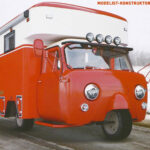 It seems that in our country starts to revive the system of renting household appliances. Hence, people with modest incomes the opportunity to use, say, digital photo and video equipment, previously inaccessible because of its cost. But if there is a technique Kodak, Sony or other well-known firms, whether to restrain themselves in the quest to understand: what is it so prized?!
It seems that in our country starts to revive the system of renting household appliances. Hence, people with modest incomes the opportunity to use, say, digital photo and video equipment, previously inaccessible because of its cost. But if there is a technique Kodak, Sony or other well-known firms, whether to restrain themselves in the quest to understand: what is it so prized?!
Even long-time owners of digital camcorders and cameras are sometimes unaware that their devices have electronic matrix, working both in the visible and near-infrared (IR) wavelength range (400-1100 nm).
That is, this technique allows great to shoot… in complete darkness.
However, this requires that either the subject is radiated heat, or highlighted the IR source, and the input to the digital camcorder or camera must be installed a filter that completely absorbs visible and ultraviolet rays. Electronic matrix (in contrast to the human eye) is able to sensitively capture the projected “IR images”, after appropriate digital processing to remember them and as needed to display in a full, high-contrast picture of the subject.

Infrared illuminator:
1 — flange; 2 — ceramic electroputere; 3 — lamp ikz-220-250 (with bulb red color); 4 — metal case; 5 — bolt М8х50 fixing to the tripod; 6 — rings-gaskets (cardboard); 7 — detachable cover; 8 — M4 screw (4 PCs); 9 — filter PL2
Images in the infrared range are significantly different from conventional photos. This is because the reflection coefficients of various materials in the infrared region are different from the reflection coefficients in the visible region of the spectrum. For example, vegetation reflects the infrared light beam in the pictures they stand out as bright areas. Reflectance from the water surface is very small, so the surface looks darker than usual images. But by having a personal computer, it’s easy to paint a black and white image in the natural, usual eye color.
Photographing and videotaping in infrared rays used in various fields of science and technology, medicine, criminology, biology, etc., among the most famous areas of application — authentication of paintings. Although for this purpose many acceptable modern methods (from microscopic analysis to study the fluorescence excited by the ultraviolet rays, and x-raying), a special value in some cases is infrared photography.
In particular, the IR images allow you to identify all the nuances of writing or the concealment of pictures under cover of a thick layer intentionally applied paint or under a badly cracked oil varnish, to determine the “hand writing style a brush” of a particular artist. It becomes also possible to read the corrected text and deleted the ancient manuscripts, fact-finding criminal scraping the labels on the documents, unlike, say, real pearls (more transparent for the infrared rays) from the artificial…
Now about the sources of infrared radiation. These should be primarily attributed to incandescent lamps operating at wavelengths close to infrared, the so — called quartz halogen compact (KGM-12-100, KGM-24-150). Designed for connection to a source of voltage 12 and 24 V, these lamps with a capacity of 100 and 150 watts installed in headlights and portable lighting and are powered from batteries, which makes videophotoshop independent from electrical networks. The average burning time of the lamp KGM-12-100 is 85 hours, and KGM-24-150 50 h. However, for stationary shots it is better to use a mirror (drying) lamps LC-220-250 or SC-220-250, integrating them into lighting fixtures.

Placement of equipment in case of special types of photos and videos:
1 — infrared illuminator; 2 — digital video camera with color filter KS 19; 3 — a digital camera with a filter KS 19; 4 — tripod tripod (3). the arrows indicate the course of the infrared rays
The IR illuminator can be homemade, to make which anyone with minimum costs. As they say, it would wish. In a case of this lighting device should not contain parts made of plastic, wood and rubber fabrics, which transmits IR rays. And the internal volume of the illuminator to avoid overheating (not to mention burning) of the filter is necessary to provide appropriate.
The best way to shoot in the infrared range suitable filters PL2 with a diameter of 195 mm. Such a filter transmits 90% of radiation in the spectral range of 800-2700 nm. “Working body” here is the black cellophane, glued on both sides on a glass substrate. Since PL2 is large enough, it is better to use a headlamp in the illumination or spotlight.
Good results shows the filter КС19. He passes 90% of radiation in the spectral range 670-270 nm. These are the filters with diameters from 40 to 360 mm produces the domestic industry.
Filter КС19 recommended for lenses of digital cameras or video cameras. As practice shows, the optimal dimensions of such filters 40x40x3 mm.
In some cases, as a source of IR radiation to use solids, such as irons, heated to a relatively low temperature. Experiments conducted by the author showed that the IR lights two irons of different capacities (500 and 250 watts, remote meter from the object) allowed us to obtain almost the same images as in visible light.
A. NORVATOV, Volsk



